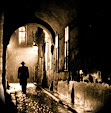
Soon after posting my review of Frozen River I came across this article from IndieWire about an argument going on between film critics A.O. Scott (NY Times) and Richard Brody (New Yorker) over an article Scott wrote about the “Neo-Neo Realism” that he claims is at work in a lot of American independent films like Chop Shop, Wendy And Lucy and the new film Goodbye Solo. Scott’s basic argument is that these movies, which generally use non-professional actors and tell simple stories about working class people, are the kinds of films that America is currently starved for, and that these filmmakers are carrying on in the tradition of Italian Neo-Realist directors like DeSica, Visconti, and early Federico Fellini. Hence the redundant name of his theory.
Brody’s lengthy response argues that Scott is “making too much” of these films and that the examples he chooses to illustrate his theory are too disorganized to add up to anything concrete. “I think it rests on questionable premises and reaches dubious conclusions,” he says. In the pedantic world of film websites and movie critics, it seems that this little argument has already grabbed a lot of attention, with different critics falling on one side or the other of the debate and wasting a whole lot of time talking about how we’re supposed to talk about movies.
Since I brought up my own little theory in the review about how movies like Chop Shop and Frozen River are operating within a wider framework, I thought I should chime in on this and give my opinion on who’s right in this debate. But after reading both of their essays, I can’t say that either one of them has much of a solid argument to back up their claims, and anyone with the least bit of film knowledge should be able to poke all kinds of holes in their theories.
For example, Brody’s objection to Scott seems to be all semantics, based around whether or not films like Killer Of Sheep are actually Neo-realist, and whether there are better examples of current films to make an argument around. As Scott said in his eventual response, “this is Mr. Brody’s way of saying that he and I like different movies.” Arguing over what movies best fit a concept that you don’t even accept as true doesn’t get you very far. This is not to mention the number of bizarre claims Brody makes near the end of his article, like when he says that the films mentioned are no more realistic than The Curious Case of Benjamin Button, a claim that is patently absurd. No matter who you are or what you think about the films in question, I think you’d have to agree that a film about a woman who loses her dog, like Wendy and Lucy, is far more rooted in reality than one about a man who is born old and ages in reverse. There’s just no argument there.
This is not to say that I agree with Scott either. His argument about these films is a little too loosely defined for my tastes, since he never seems to make a distinction about whether he’s talking about how these movies are made (handheld camera, location shooting, non-professional actors), or the stories they tell (working class struggles, social issues), or both. In any case, any two of the films he mentions have only a couple of these aspects in common. In this regard, I would agree with Brody that Scott is a bit too hasty to give a name to a movement that hasn’t really developed any recognizable characteristics.
And this is all without getting into the whole philosophical argument about what it means to be “realistic” on screen and whether or not it’s even a goal to aspire to. As Brody mentions, all the early practitioners of Neo-Realism eventually abandoned it in favor of more conventional styles that would allow them to tell bigger, deeper stories by using all the technological tools at their disposal. This was certainly true of Fellini, who abandoned the neorealist style in order to more deeply explore the psychological aspects of his characters. Movies are about telling stories, plain and simple. If a director thinks one style is best suited to telling a specific tale, or if it allows them to shoot it more quickly or cheaply, then they should use it. They shouldn’t worry about whether they’re going to be classified one way or another, or limited by what label they are given. That’s the kind of territory you venture into when you start trying to name a style before it’s even really developed.
Which brings me back to Frozen River, Chop Shop, and Shotgun Stories. The only thing I can really see linking these films together is a desire to document parts of American culture that are otherwise ignored. Films from Hollywood don’t exist in any American culture. They exist in a streamlined, homogenized movie culture that they all feed on and build up to the point that it can stand in for the real thing. America is a big country, and just because everyone shops at Target and Wal-Mart it does not mean we all live in the same culture. If there is any kind of a movement going on in film right now, it just might be the desire to break away from the construct and start documenting the culture beyond New York and Los Angeles. But beyond this impulse, which seems to be presenting itself in countless forms, I have to agree with Brody that there isn’t anything closely enough resembling a new style to be worth classifying, especially not with a name as pretentious and loosely defined as “Neo-Neo Realism”.


No comments:
Post a Comment